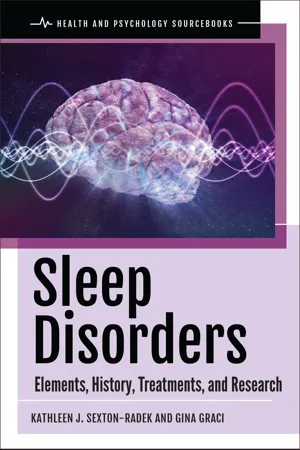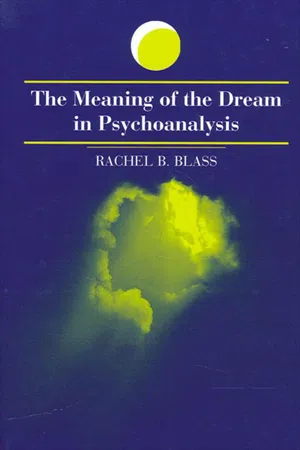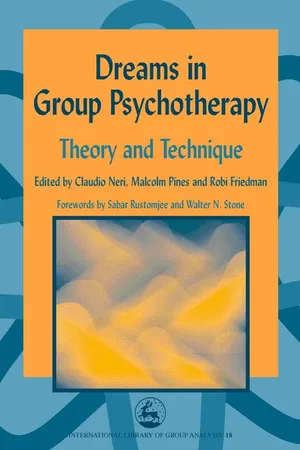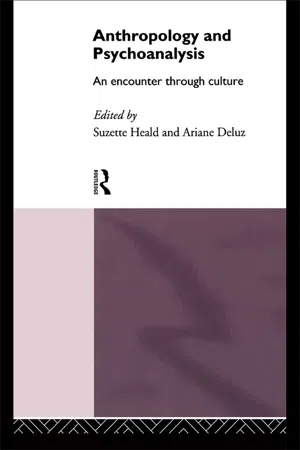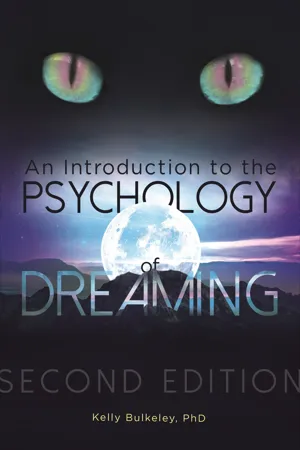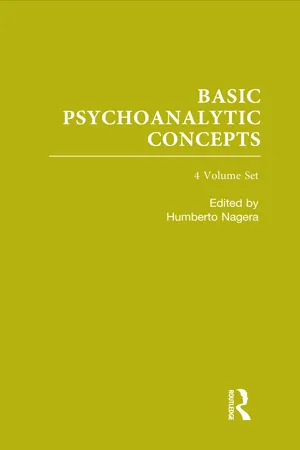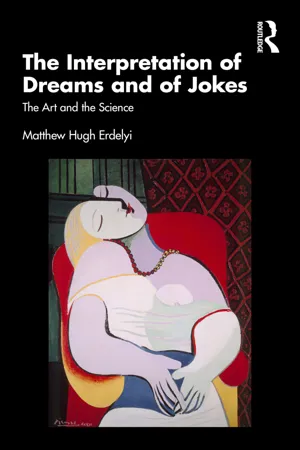Psychology
Dream Analysis
Dream analysis is a therapeutic technique used to explore the unconscious mind by interpreting the content of dreams. It is based on the idea that dreams can reveal hidden desires, fears, and unresolved conflicts. Psychologists use various methods to analyze dreams, such as free association and symbolism interpretation, to gain insight into a person's emotions and experiences.
Written by Perlego with AI-assistance
Related key terms
1 of 5
12 Key excerpts on "Dream Analysis"
- eBook - ePub
Sleep Disorders
Elements, History, Treatments, and Research
- Kathleen J. Sexton-Radek Ph.D., Gina Graci(Authors)
- 2021(Publication Date)
- Praeger(Publisher)
CHAPTER 10 Dreaming as a Psychological ProcessW hy do we dream, why are some dreams frightening, and why do we only remember some of our dreams? Hypotheses have abounded for years regarding the meaning and biological or neurological pathway of dreams. Some people earn a living by analyzing dreams, but what do dreams really mean, and what is the current dream landscape? The symbolic meaning of dreams is called the latent content of dreams, and many people believe there are hidden messages in dreams. Some scientists believe that dreaming is related to depression, and some therapists postulate that if the unconscious meaning of dreams can be interpreted, then psychological distress could be relieved (Cherry, 2020). This chapter will explore dreaming as a psychological process.A dream is defined as a physiologically and psychologically conscious state that occurs during sleep. It is often characterized by a rich array of endogenous sensory, motor, emotional, and other experiences (American Psychological Association [APA], 2020). Dreams mainly occur in rapid eye movement (REM) sleep and may be logical or illogical. Dream interpretation is the attempt at finding meaning from dreams as it applies to an individual’s life.Sigmund Freud believed that the meaning and content of dreams were heavily encrypted and hard to translate (Lyon, 1990). The hidden meaning of dreams played an important role in Freud’s psychoanalytic theory, and he believed that bringing the hidden meaning of a dream into conscious awareness could relieve psychological distress (Freud, 1913). For instance, Freud believed that the latent content of a dream was not only suppressed but hidden by the subconscious mind to protect the person from thoughts and feelings that were hard to cope with (Cherry, 2020).While the function of sleep is hypothezied to be based on restorative properties, there is no concluding evidence that this is true. The early work of Dr. Rosalind Cartwright (the Grandmother of Sleep) showed the scientific measurement of sleep and dreaming, primarily dreams and the process of dreaming. “Dreams,” wrote Cartwright, “are our private perceptions which cannot be validated or shared by others” (Cartwright, 1977). She also postulated that dreams may “provide us with a direct cure for certain mental problems long before anyone determines exactly what sleep and dreaming are for” (Lyon, 1990). - eBook - ePub
Dream Analysis
A Practical Handbook of Psychoanalysis
- Ella Freeman Sharpe(Author)
- 2018(Publication Date)
- Routledge(Publisher)
One wonders sometimes if the pendulum has swung to the opposite extreme, and if instead of an over-valuation of dreams as a means of analysing a patient we are not in some danger of undervaluation. We may need to take stock again of the value of dreams, and to make an assessment concerning dreams in general.We must remember that the interpretation of dreams stands as the corner-stone of psychoanalysis, and that mainly by such interpretation psycho-analysis first earned by the cures achieved, adherents to the new therapy. The dream still remains I believe an important and almost indispensable means of understanding unconscious psychical conflicts.I will give first some advantages the analyst himself stands to gain by understanding a patient's dreams. Dreams serve as a kind of reference in analytic work. We can gauge by dreams, if we can interpret them, how true or wide of the mark are our interpretations of the patient's general run of associations, of his gestures or behaviour. We eventually either get corroborations of our interpretations or we find that the patient's dreams indicate that we are not grasping the trend of affairs. I do not mean that we can understand every dream recounted by the patient nor can we follow up clearly the psychical problems from one dream to the next continuously. If we could see the end from the beginning we should be as gods. I mean that at intervals we shall find dreams being told to us that show our analytic interpretations are accurate since they will be followed by dreams that corroborate and pursue and unfold further material of the relevant theme. Here is an example of the process I mean. A patient noticed during an hour's analysis some catkins in a vase. She spoke of the pollen falling from them and then of the prodigality of nature. Her thoughts were "tuned in," so to speak, to one idea, that of profusion and generosity. The people who came to her mind were all of one type, generous with money, with ideas, with affection. The analyst said: "There was surely a time when you thought of your father as a generous giver. You seem to have thought of him as having abundance of good things which he gave generously, so much so he could afford not to care if there was waste." To this the patient replied incredulously, "But my father as long as I can remember only gave me two presents." The analyst replied, "That's as far back as you can remember, but you don't remember earlier than four years of age, do you?" The patient agreed. The next day the patient told a dream in which "running water" was the main element. This evoked associations leading to her memory of the ecstasy she felt on first seeing a waterfall. The inference was drawn that she had first experienced this kind of excitement on seeing her father's penis while he was urinating. During the hour there suddenly came to the patient a vision of hanging fruit, clustered pears she thought, and finally she herself volunteered that this picture must be a representation of her father's genitals seen in infancy when primitive oral desires hallucinate fulfilment from shapes that resemble the breast and nipple. This illustrates the value of the dream from the analyst's point of view, namely as a kind of touchstone of the validity of interpretation. Dreams will tell us whether we are really in touch with the unconscious mind of the patient. There are dreams we can only partially interpret in the light of the material given. We have only a partial understanding of an unfolding situation. There are other dreams which confirm and elaborate the accurate interpretations we have given. From this point of view, for grip of his own work, the dream is invaluable for the analyst. - eBook - ePub
- C.G. Jung(Author)
- 2014(Publication Date)
- Routledge(Publisher)
Dream-Analysis in Its Practical Application
DOI: 10.4324/9780203991701-1The use of dream-analysis in psychotherapy is still a much-debated question. Many practitioners find it indispensable in the treatment of neuroses, and ascribe as much importance to the psychic activity manifested in dreams as to consciousness itself. Others, on the contrary, dispute the value of dream-analysis, and regard dreams as a negligible by-product of the psyche.Obviously, if a person holds the view that the unconscious plays a leading rôle in the formation of neuroses, he will attribute practical significance to dreams as direct expressions of the unconscious. If, on the other hand, he denies the unconscious or thinks that it has no part in the development of neuroses, he will minimize the importance of dream-analysis. It is regrettable that in this year of grace 1931, more than half a century since Carus formulated the concept of the unconscious, over a century since Kant spoke of the “immeasurable … field of obscure ideas”, and nearly two hundred years since Leibniz postulated an unconscious psychic activity, not to mention the achievements of Janet, Flournoy and Freud—that after all this, the actuality of the unconscious should still be a matter for controversy. Since it is my intention to deal exclusively with questions of practical treatment, I will not attempt in this place a defence of the hypothesis of the unconscious, though it is obvious enough that dream-analysis stands or falls with this hypothesis. Without it the dream appears to be merely a freak of nature, a meaningless conglomerate of memory-fragments left over from the happenings of the day. Were the dream nothing more than this, there would be no excuse for the present discussion. We must recognize the unconscious if we are to treat of dream-analysis at all, for we do not resort to it as a mere exercise of the wits, but as a method for uncovering hitherto unconscious psychic contents which are causally related to the neurosis and therefore of importance in its treatment. Anyone who deems this hypothesis unacceptable must simply rule out the question of the practicability of dream-analysis. - eBook - PDF
- Rachel B. Blass(Author)
- 2012(Publication Date)
- SUNY Press(Publisher)
Furthermore, we have not succeeded in completely doing away with the possibility that regarding some dreams all that can be done is assign new meanings; that for some there may be no way of discovering their meaning 208 The Meaning of the Dream in Psychoanalysis or even of knowing that they have any meaning at all. Under these special con- ditions it would seem that the optimal clinical stance in the course of Dream Analysis would involve the combination of the psychoanalytic relentless pursuit of the various kinds of meanings that actually exist within the individual, together with a careful and limited doubt regarding the meaningfulness of some dreams. Such a stance would allow us to plummet the depths of the meanings of the dream and at the same time open a path to the future resolution of the question of whether indeed all dreams have discoverable meaning. CONCLUSION In 1900, Freud wrote that “the interpretation of dreams is the royal road to the knowledge of the unconscious activities of the mind” (Freud, 1900, p. 608). Although this statement is commonly taken to mean that Dream Analysis pro- vides the best access to the individual’s unconscious meanings, a careful reading of the context reveals that its more immediate meaning is that dream interpreta- tion offers the best access to the understanding of the general processes of the mind. The continuation of the statement is as follows: “By analyzing dreams we can take a step forward in our understanding of the composition of that most marvelous and most mysterious of instruments. Only a small step, no doubt; but a beginning” (ibid.). Freud was speaking here of the value of dream inter- pretation to the understanding of broader mental processes. The present study has furthered Freud’s endeavor to stride toward a deeper understanding of the marvels and mysteries of the mind. - eBook - PDF
Dreams in Group Psychotherapy
Theory and Technique
- Robi Friedman, Claudio Neri, Malcolm Pines(Authors)
- 2002(Publication Date)
- Jessica Kingsley Publishers(Publisher)
The dream is the best possible expression of itself and not necessarily a disguise for something else. Thus, instead of being an authority on interpretation of hidden meanings, the analyst’s interpretive activity now has the primary task of amplifying and elucidating the patterns of meanings manifested in the dream imagery. The second essential aspect (which probably more than any other facet distinguishes a self-psychological approach) is also directly connected to Kohut’s description of the self-state dream. Even when the thematic structure of a dream contains defensive elements and conflict, a self psychologist’s guiding theoretical framework has a different focus than that of the classical analyst. Rather than observing the associative material in terms of interacting forces of id, ego and superego or infantile drives and prohibitions, the self psychologist’s orienting principle (Tolpin 1983) is a focus upon the vicissi-tudes of the self. When conflict is involved, the essential conflicts are seen as being between self and self-objects. Dreams are still seen as a ‘royal road’. However, self psychology has a different conception of what important expe-riences and ideas lie out of awareness than the classical analyst does. As Stolorow (1978) expresses it, dreams are seen as the ‘royal road’ to the indi-vidual’s invariant organising principles and dominant leitmotivs which unconsciously pattern and thematise a person’s subjective experiences of his or her self and self–self-object relationships. 180 DREAMS IN GROUP PSYCHOTHERAPY Dreams are not seen as disguised material requiring interpretation to uncover the latent drives hidden beneath their content. However, the self psy-chologist’s approach to dreams still is based on an interpretive process. The focus of this interpretive activity is on the working through of the self-object transferences and conflicts between self and self-objects. - eBook - ePub
Anthropology and Psychoanalysis
An Encounter Through Culture
- Ariane Deluz, Suzette Heald(Authors)
- 2002(Publication Date)
- Routledge(Publisher)
Part II The analysis of dreams
Passage contains an image
6 Dream imagery becomes social experience The cultural elucidation of dream interpretation1
Iain Edgar
Dreaming is a universal aspect of being human. It appears to be the most private and hidden activity which is usually perceived as being both unpredictable and often incomprehensible. Yet most human societies have sought to understand dream imagery and many have accorded such imagery and its interpretations high, even prophetic, significance. The paradoxical and ambivalent position of the dream is well illustrated in western industrialised societies where, on the one hand, ‘interpreting dreams’ is seen as a highly specialised task reserved for psychoanalysts and needing a long and challenging training. On the other hand, dreaming is denigrated as being wholly illusory, as being just a ‘dream’ and of no consequence.Tedlock (1987a) has traced the origin of western disregard of the value of dreaming back to Aristotelian scholasticism. The development of Cartesian dualism in the seventeenth century set the seal on the relegation of dream imagery to the realm of the unreal. The ‘oppositional dichotomy’ (Tedlock, 1987a:2) thus erected between subjective and objective reality, reality and unreality, meant the exclusion of dreaming from serious consideration in the west until the twentieth century. Freud’s development of psychoanalysis, his use of dream imagery and his conceptualisation of the unconscious clearly started a new era in terms of the evaluation of the dream. Such a historical and negative evaluation of the dream is not however universal. In the Indian Hindu tradition dreaming is placed above waking reality in the hierarchy of realities (Tedlock, 1987a:3). In the Islamic Sufi tradition a form of reality is identified which is midway between sensibility and spirituality. This is identified by Corbin (1966) as the ‘imaginal world’ which is an autonomous world of imagery and forms accessible through both dreaming and techniques of active imagination (Price-Williams, 1987). Moreover, outside the great world religious traditions there is abundant evidence from anthropologists to show that many non-industrialised societies value and use dream imagery as part of their participatory experience of reality (Tylor, 1871; Firth, 1934; Devereux, 1951; Hallowell, 1966; Tedlock, 1987a; Herdt, 1987; Mannheim, 1987). - Kelly Bulkeley Ph.D.(Author)
- 2017(Publication Date)
- Praeger(Publisher)
However, others (like Boss) reject associations and amplifications and say that interpretation should focus exclusively on the dreamer’s experience itself. Still others (like Hall) argue that even the dreamer is unnecessary because nothing more than a series of written dream reports is required to make valid interpretations. Modern Psychology’s Answers to the Three Basic Questions about Dreaming 131 Many psychologists (Freud, Jung, Adler, Boss, French and Fromm) regard the aid of a trained psychotherapist as a valuable or even essential part of dream interpretation. Others (Hill, Hall, Faraday, Garfield, Delaney) dis- agree, saying that with a little practice any person can learn to interpret his or her own dreams. And for some (Perls, Ullman, Taylor), the ideal setting for dream interpretation is neither one-to-one psychotherapy nor private reflection and journal writing, but a dream-sharing group. Finally, some psychologists (Freud, Hall) argue that dream interpretation can be precise, objective, and scientific in its results. Most psychologists, how- ever, believe that dream interpretation is more of an intuitive art in which many complex and multivalent meanings emerge out of each dream. Modern Psychology’s Answers in the Context of Western History As a final way of evaluating the answers given by modern psycholo- gists to the three basic questions, they may be compared to the answers given earlier in Western history to the same questions. The Bible A number of modern psychologists (Jung, Boss, Hunt) basically agree with the Bible that at least some of our dreams are formed by God or by other divine, supernatural, or transpersonal forces. The theories of these psychologists also correspond closely to the Bible’s portrayal of dream functions as providing spiritual revelations, prophecies, and warnings of possible danger relevant to individuals and the broader community.- eBook - PDF
- Laura Marcus(Author)
- 2024(Publication Date)
- Manchester University Press(Publisher)
2 It is also the most important and influential text of psycho- analysis itself. The British analyst Ella Freeman Sharpe, in her study Dream Analysis (1937), described it as 'the first text-book for psycho-analysts',3 and the function and significance of dreams and dream-interpretation (in analytic training, practice and theory) continue to preoccupy psychoanalysis to the present day. 4 In The Interpretation of Dreams Freud provided the most com- prehensive account of the psychoanalytic conception of the mind. The leading metaphor of the text is that of the journey, with Freud guiding the reader through the landscape of mental life. The text is divided into seven chapters which explore: (I) the existing literature on dreams; (II) the 'associative' method of dream- interpetation, in which Freud analysed one of his own dreams as a 'specimen' dream; (III) the overarching thesis that 'a dream is the fulfilment of a wish'; (IV) the role of distortion in dreams; (V) the material and sources of dreams, including typical dreams; (VI) the 'dream-work', the means by which the 'latent' (unconscious) dream thoughts are disguised and transformed into the' manifest' dream content; (VII) the metapsychology of the dream-processes, including the workings of 'regression', 'wish-fulfilment' and 'repression'. While Chapters II to VI primarily explore the workings of both dreams and dream-interpretation, Chapter VII investigates the nature of the mental apparatus which not only produces dreams but seems to require them for its effective functioning. Freud's theories postulated two central theses: first, that dreams have a meaning accessible to interpretation; and second, that they have a function. Dreams are 'compromise formations', expres- sions of wishes and of defenses against those wishes. - eBook - PDF
Mapping the Mind
The Intersection of Psychoanalysis and Neuroscience
- Fred M. Levin(Author)
- 2018(Publication Date)
- Routledge(Publisher)
Given the complexity of the subject and the large number of possible approaches, I would now like to review some of what I consider to be useful work in the field of sleep dream research, that is, work that seems to me to allow some significant bridging to occur. In doing so, I will try to be relevant and clarifying rather than comprehensive. In general, I will follow the major biological and psychological areas noted earlier. I wish to state at the outset that Max Stern's work is the inspiration for the comments that follow. II Freud's (1900) Interpretation of Dreams was the beginning of scientific Dream Analysis. Subsequent psychoanalytic dream research of note (other than those research efforts mentioned in the first part of this essay) includes the contributions of French (1952) and Fromm (1947), who focused and extended dream interpretation within the Freudian tradi-tion; Altman (1975), who summarizes Freud's lengthy and detailed dream treatise into one highly readable volume; Friedman and Fisher (1967), who relate basic rest and activities cycles of the brain to dreams; and Berger (1967), Greenberg (1970), Wasserman (1984), Gabel (1985), and Slap and Trunnell (1987), who have each made special clarifications regarding the task of bridging dream with sleep research. The position of Freud regarding dreams, simply stated, is that when impulses and wishes from early, instinctual life (latent dream thoughts), and current experience (the day residue) resonate sufficiently with and reinforce each other, then one's latent dream thoughts are converted into a manifest dream by way of process Freud referred to as dream work. This work involves a variety of mechanisms, including condensation, displacement, symbolization, and pictorial metaphor formation. Once produced, the hidden meanings of the dream continue to be protected from discovery by the continuation of defensive mechanisms. - eBook - ePub
- Rosine Jozef Perelberg(Author)
- 2018(Publication Date)
- Routledge(Publisher)
IntroductionRosine Jozef PerelbergThe publication of Freud's The Interpretation of Dreams (1900) could be said to mark the birth of psychoanalysis, as dreams became paradigmatic of the unconscious (Green, 1986, 2000). It is not surprising, therefore, that dream interpretation, as it is practised currently in the British Psycho-Analytical Society, bears the mark of the modern advances and discoveries in the field of psychoanalysis itself.This present book contains some modern contributions to the understanding and interpretation of dreams developed by contemporary psychoanalysts in the British Society. At its core is an exploration of the connections between dreaming and thinking, and the way in which dreams may provide the analysts' best clues to their patients' states of mind. The varied contributions to this volume further extend the perception that the interpretation of dreams allows access to a theory of mind, to the ways in which analysands conceive their experiences of their inner world of thoughts and feelings. It is crucial for the analyst, during a session, to differentiate, conceptually and clinically, between different types of mental processes. An understanding of the type of constructs presented by patients—i.e. the quality, content or function of their dreams, daydreams thoughts or actions—at each moment in an analytic session represents an important means of identifying the structure of their psychic states. Each author crucially links dreams to the transference, so facilitating a deeper understanding of the analytic process itself. The ten patients who are discussed in this book bring to their analysts their innermost primitive and distressed feelings, and seek their help.In 1993, Flanders edited an excellent book, The Dream Discourse Today, - eBook - PDF
- Humberto Nagera(Author)
- 2022(Publication Date)
- Taylor & Francis(Publisher)
Furthermore, the capacity to comprehend and the level of insight possible for any given person or group of persons engaged in such work increases as the work proceeds. Thus certain formulations become more meaningful, are suddenly understood in a new light, assume a different significance, etc. Because of our realization of 13 potential shortcomings we hope that future readers of these con- cepts will contribute to complete and clarify the work which the Concept Group has started, by drawing our attention to relevant material which has been either overlooked, misrepresented or not understood in its full significance. It is hoped that in this way the Concepts will become more and more representative and complete in the course of time. DR HUMBERTO NAGERA. T H E T H E O R Y OF D R E A M S 14 THE CONCEPT OF DREAMS Definition of Dreams A dream is the (disguised) fulfilment of a (repressed) wish.1 This formulation may be regarded as Freud’s most concise definition of a dream. A comprehensive definition of dreams, as conceived by Freud, should cover the total phenomenon of which the latent dream content, the dream-work and the manifest dream are the several, component parts. The dream-work is the most ‘essential’ part.2 Only through understanding its laws and conditions can we reach the latent dream content which contains the true and dis- guised wish.3 Dreams are the fulfilment of wishes4 in the service of the preservation of sleep. - eBook - ePub
The Interpretation of Dreams and of Jokes
The Art and the Science
- Matthew Hugh Erdelyi(Author)
- 2022(Publication Date)
- Routledge(Publisher)
There are, however, additional layers of meaning that emerge with more context—for example, that Dolores P. had just finished a section of her Introduction to Psychoanalysis course that dealt with Freud’s theory of sexual symbols. This additional information imparts a potential new meaning to the bucket and spouting-hose element of the dream. With the condensation of the two sets of elements (sex-office), an additional—and taboo—meaning emerges (sex in the professor’s office). Thus, in this simple and short dream, at least five meanings can be discerned, two surface layers of meaning (rectangles within a rectangle, bucket and a spouting hose), two latent meanings (professor’s office, sex), which arose from the interaction of manifest contents with context, and a still deeper taboo wish, involving the interaction of interactions (conceived of as a “second-order interaction” in statistics). Thus, this simple, short dream features a mix of three semantic levels—two manifest contents, two latent contents, and a still more latent (deeper) latent content. Context is the Key to Latent Meanings The notion that context is a key to deep meanings has been a leitmotif of our book. We saw this in our discussions of Freud, who discovered latent contents in dreams—and, also, in other release-phenomena such as hysterical symptoms, jokes, fairy tales. In Freud’s approach, the context is generated through free-associations, a preamble, and clinical queries. In Jungian approaches (see, e.g., the clinical demonstrations of Delaney (1979)), the context is generated through the clinician’s elicitation of amplifications, which are focused elaborations by the patient of details regarding the nature, function, and feeling-tone of elements of a dream. In still other approaches, such as Gestalt Therapy, outlandish play-acting brings out new, sometimes unexpected contexts to clinical issues
Index pages curate the most relevant extracts from our library of academic textbooks. They’ve been created using an in-house natural language model (NLM), each adding context and meaning to key research topics.
